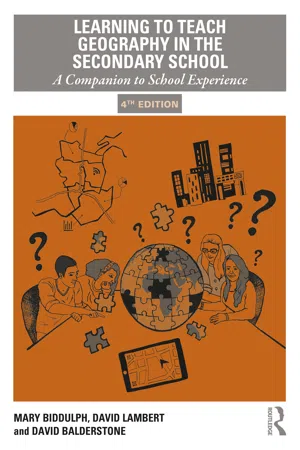
Learning to Teach Geography in the Secondary School
A Companion to School Experience
- 302 pages
- English
- ePUB (mobile friendly)
- Available on iOS & Android
Learning to Teach Geography in the Secondary School
A Companion to School Experience
About this book
Learning to Teach Geography in the Secondary School has become the widely recommended textbook for student and new teachers of geography. It helps you acquire a deeper understanding of the role, purpose and potential of geography within the secondary curriculum, and provides the practical skills needed to design, teach and evaluate stimulating and challenging lessons.
It is grounded in the notion of social justice and the idea that all students are entitled to a high-quality geography education. The very practical dimension provides you with support structures through which you can begin to develop your own philosophy of teaching and debate key questions about the nature and purpose of the subject in school.
Thoroughly updated to take account of the latest research, evidence and policy, this new edition reflects new developments in technology as well as current thinking on curriculum, pedagogy and assessment. Exploring the fundamentals of teaching and learning geography in school, chapters cover:
- Why we teach geography – its purposes and intent
- Understanding and planning the curriculum – what to teach
- Effective pedagogy – how to teach
- Inclusion
- Assessment
- Developing and using resources
- Fieldwork and outdoor learning
- Values and school geography's contribution to 'citizenship'
- Professional development
Intended as a core textbook and written with both university and school-based initial teacher education in mind, Learning to Teach Geography is essential reading for all those who aspire to become able, effective and above all, thoughtful and reflective teachers.
Frequently asked questions
- Essential is ideal for learners and professionals who enjoy exploring a wide range of subjects. Access the Essential Library with 800,000+ trusted titles and best-sellers across business, personal growth, and the humanities. Includes unlimited reading time and Standard Read Aloud voice.
- Complete: Perfect for advanced learners and researchers needing full, unrestricted access. Unlock 1.4M+ books across hundreds of subjects, including academic and specialized titles. The Complete Plan also includes advanced features like Premium Read Aloud and Research Assistant.
Please note we cannot support devices running on iOS 13 and Android 7 or earlier. Learn more about using the app.
Information
1
Why teach geography?
Introduction
should never forget or abandon those ideals which draw us to the job in the first place. School geography has the potential to develop young people’s understanding of their ‘place’ in the world and so help form their identity.(Huckle, 1997: 41)
- consider what is geography’s distinctive contribution to the school curriculum;
- contribute to the professional debates concerning the nature of geography in the school;
- understand the changing relationship between school and academic geography and connect your own academic interests with developments in the school curriculum;
- understand ‘the knowledge debate’ and how this impinges on the kinds of geographical knowledges that are taught in schools;
- locate school geography in England within a wider discourse about school geography internationally.
Thinking geographically and GeoCapability
The function of geography in school is to train future citizens to imagine accurately the conditions of the great world stage and so to help them to think sanely about political and social problems in the world around.(Fairgrieve, 1926: 18)
Table of contents
- Cover
- Half Title
- Series Page
- Title Page
- Copyright Page
- Table of Contents
- List of Illustrations
- List of Tasks
- List of Boxes
- Introduction
- 1 Why teach geography?
- 2 The geography curriculum
- 3 Pedagogy
- 4 Pupils’ learning
- 5 Inclusion
- 6 Resources
- 7 Fieldwork
- 8 Assessment
- 9 For citizenship
- 10 Professional development
- Index